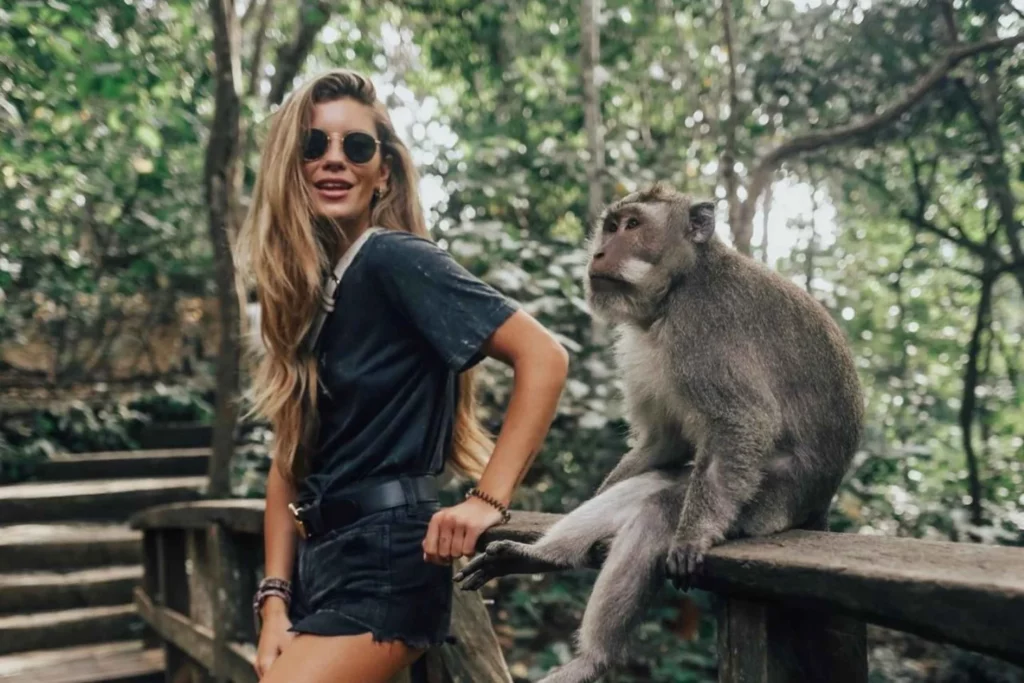Sacred Monkey Forest Sanctuary in Ubud
Located in the heart of Ubud, the mystical Monkey Forest Sanctuary is home to over 700 Balinese long-tailed macaques and three ancient Hindu temples dating back to the 14th century.
It’s an incredible blend of nature, spirituality, and culture, making it a must-visit destination for anyone traveling to Bali.
The Monkey Forest of Ubud, also known as Mandala Wisata Wenara Wana, is a nature reserve and Hindu temple complex steeped in history and tradition. Its origins can be traced back to the ancient Balinese belief in the divine power of monkeys, which are considered the guardians of sacred places. It is one of Bali’s prized destinations.
The cost of entry is 80,000 IDR (approximately $6 USD) for adults and 60,000 IDR (approximately $4 USD) for children. The fees go towards maintaining the sanctuary and supporting the local community. It’s one of the best bargains to spend your money on an adventure or travel expenditure. You really get your money’s worth while the money goes to go use while you can spend as much time there as you want.

Upon entering the forest, you are immediately transported into a world that feels almost otherworldly. The lush green foliage, towering trees, and soft moss-covered stone pathways create a serene atmosphere that is both enchanting and calming. The chattering and playful antics of the monkeys, combined with the rich history of the temples, create a uniquely Balinese experience.

The monkeys themselves are fascinating creatures. They are intelligent, curious, and quite bold. It’s not uncommon for them to approach visitors in search of food or simply to investigate. Be sure to follow the sanctuary’s guidelines for interacting with the monkeys: never feed them anything other than the fruit provided at the park, avoid making direct eye contact, and never touch or hold them – but do expect them to touch you, playfully that is.

The staff at the Monkey Forest are friendly and knowledgeable, always eager to provide information about the monkeys and the sanctuary’s history. They can also help you capture some amazing photos with the monkeys – just be prepared for some close encounters! The monkeys might climb onto your shoulders or sit in your lap, but don’t worry, the staff will ensure your safety and the monkeys’ well-being throughout the experience.
The Sacred Monkey Forest Sanctuary in Ubud is an enchanting destination that allows you to immerse yourself in the natural beauty, spirituality, and culture of Bali. With so many monkeys to interact with and the helpful staff on hand to guide you, a visit to the Monkey Forest is sure to create lasting memories. It’s an experience I cherish as an expat living in Bali and one that I wholeheartedly recommend to both tourists and fellow expats alike.

Monkey Forest Ubud offers a unique experience that goes beyond the traditional confines of a zoo, because it isn’t. THere’s many reasons why it stands out as a more authentic and engaging attraction.
Natural Habitat: Unlike zoos, where animals are often confined to small enclosures, the Monkey Forest provides a more extensive, natural environment for the monkeys to roam freely. The dense forest, with its native flora and fauna, allows visitors to observe the monkeys in a setting that closely resembles their natural habitat, resulting in more authentic and ethically responsible wildlife encounters.
Animal Welfare: In the Monkey Forest Ubud, the monkeys are not kept in cages or subjected to unnatural conditions. They have the freedom to interact with one another, explore their surroundings, and form their social hierarchies without human interference. This promotes healthier, more natural behaviors and contributes to the overall well-being of the animals.

Cultural and Spiritual Significance: The Monkey Forest is not just a wildlife sanctuary but also a sacred site with deep cultural and spiritual significance for the Balinese people. The presence of ancient Hindu temples and the monkeys’ role as guardians of these sacred spaces create a unique atmosphere that transcends the typical zoo experience. Visitors can gain insight into Balinese culture, spirituality, and the importance of maintaining a harmonious relationship with nature.
Educational Opportunities: The staff at the Monkey Forest is dedicated to educating visitors about the monkeys, their habitat, and Balinese culture. By engaging with the staff and observing the monkeys in their natural environment, visitors can learn about the unique characteristics of Balinese long-tailed macaques, their social structure, and the role they play in the ecosystem.
Sustainable Tourism: The Ubud Monkey Forest promotes sustainable tourism by reinvesting the revenue generated from entrance fees into the preservation of the sanctuary and the surrounding community. This approach helps maintain the forest’s ecological balance, supports local livelihoods, and preserves the area’s cultural heritage for future generations.

The Ubud Monkey Forest offers a more immersive, authentic, and responsible experience compared to traditional zoos because it isn’t one nor is it trying to be. By allowing visitors to witness the monkeys in their natural habitat and fostering a deeper understanding of Balinese culture and spirituality, the Monkey Forest creates an unforgettable experience that goes beyond mere entertainment.

The Sacred Monkey Forest Sanctuary in Ubud is an enchanting destination that allows you to immerse yourself in the natural beauty, spirituality, and culture of Bali. With so many monkeys to interact with and the helpful staff on hand to guide you, a visit to the Monkey Forest is sure to create lasting memories. It’s an experience I cherish as an expat living in Bali and one that I wholeheartedly recommend to both tourists and fellow expats alike.
Visit their official website for details.






